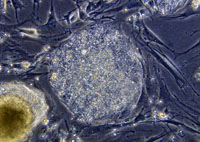Is it possible to fight AIDS by stem cells?
But the research "is not ready for prime time," cautioned study co-author Dr. Jerome Zack, a UCLA professor of medicine, microbiology, immunology and molecular genetics, according to the Forbes.

At the center of the research are embryonic stem cells, which have been hugely controversial in recent years. Stem cells have the ability to transform themselves into a variety of cells, a fact that thrills scientists who think their manipulation could restore or boost ailing parts of the body.
In experiments, scientists confirmed a cell culture surface molecule called laminin activates a common developmental pathway that is crucial for the generation and survival of particular types of brain cells.
The laminin-influenced stem cells are a kind that goes on to generate a brain structure called the medial ganglionic eminence, which in turn is believed to give rise to a population of early neurons in the developing cerebral cortex, a structure that helps coordinate sensory, motor and cognitive function.
In that respect, the discovery sheds light on how embryonic stem cells diversify to form various neural structures, one of the fundamental mysteries of brain development, according to the Health Day News.
Subscribe to Pravda.Ru Telegram channel, Facebook, RSS!




